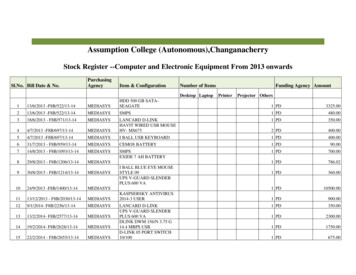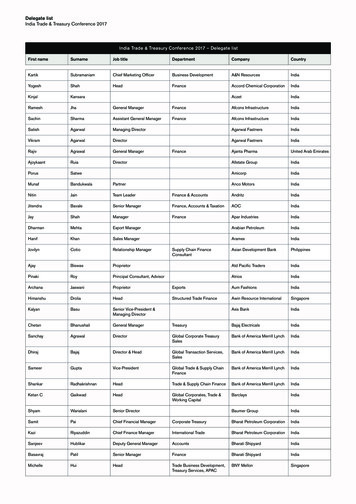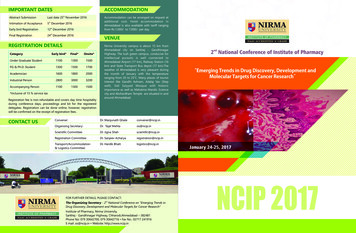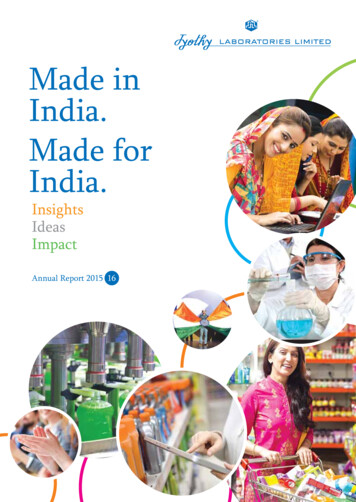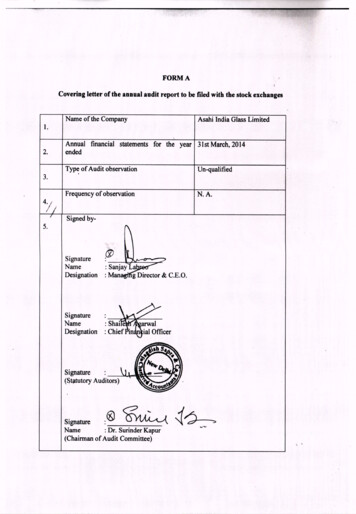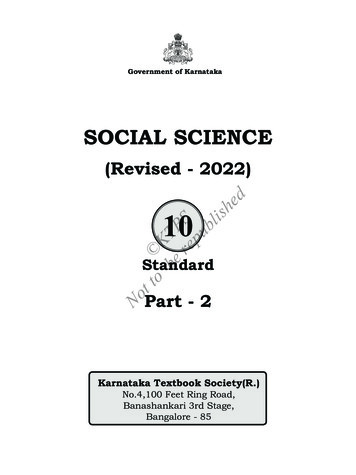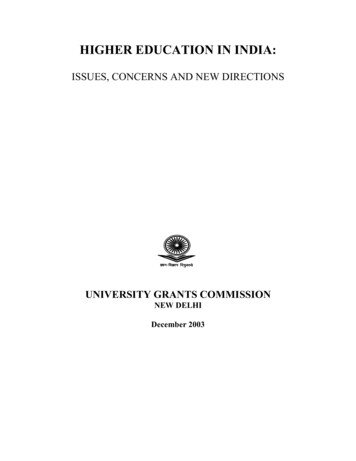
Transcription
HIGHER EDUCATION IN INDIA:ISSUES, CONCERNS AND NEW DIRECTIONSUNIVERSITY GRANTS COMMISSIONNEW DELHIDecember 2003
HIGHER EDUCATION IN INDIAISSUES, CONCERNS AND NEW DIRECTIONSRECOMMENDATIONS OFUGC GOLDEN JUBILEE SEMINARS- 2003HELD AT ELEVEN UNIVERSITIES IN INDIAUNIVERSITY GRANTS COMMISSION, NEW DELHIDecember 2003
(i) 2003, The University Grants CommissionEditorial Committee(Names of members, preferably in alphabetical order to be given)Printed and published by the Secretary, UGCFor the University Grants Commission,Bahadur Shah Zafar Marg, New Delhi 110 002, India;Printed at (ii)
ForewordThe higher education system in India has grown in a remarkable way, particularly in thepost-independence period, to become one of the largest system of its kind in the world.However, the system has many issues of concern at present, like financing andmanagement including access, equity and relevance, reorientation of programmes bylaying emphasis on health consciousness, values and ethics and quality of highereducation together with the assessment of institutions and their accreditation. Theseissues are important for the country, as it is now engaged in the use of higher educationas a powerful tool to build a knowledge-based information society of the 21st Century.Recognizing the above and the basic fact, that the Universities have to perform multipleroles, like creating new knowledge, acquiring new capabilities and producing anintelligent human resource pool, through challenging teaching, research and extensionactivities so as to balance both the need and the demand, the University Grantscommission (UGC) had initiated nation wise discussion on the said issues during itsGolden Jubilee Year, 2003. Eleven Universities located in different regions of the wereassigned the task of conducting Seminars on identified topics in the above areas, duringAug-Nov., 2003 and come out with their Reports and Recommendations.An Editorial Committee was constituted by UGC to consider the outcome of theseSeminars and compile them suitably so that an appropriate publication can be brought outfor the use of UGC, higher education planners and the University system itself. I am gladthat this publication, Higher Education in India: Issues, Concerns and New Directions isa result of these efforts.I would like to place on record our deep sense of appreciation to the eleven Universitiesto whom the Seminars were assigned, for their timely actions of planning/coordinatingthe Seminars and their pains taking work in prepar9ng the detailed proceedings, and tothe learned / experienced resource persons and delegates for keen interest and activeparticipation in the deliberations.(iii)
I would also like to thank the Editorial Committee for compiling and editing the reportsreceived from the Universities and bringing out this useful publication in time. I amquite certain that this publication will help in giving a new direction aimed at the 21stcentury expectations to the Indian higher education system and accelerate its pace ofdevelopment to meet the needs and aspirations of the society at large.New DelhiDecember, 2003Arun NigavekarChairman, UGC(iv)
CONTENTSPage Nos.ForewordExecutive SummaryI.Management of Higher Education1.11.21.31.41.5Public/Private PartnershipGovernanceAccess and EquityPolicy Planning for ExportEconomics of Higher EducationII.Reorientation of Higher Education2.12.22.3Health Consciousness and Physical FitnessProfessional Ethics and Value EducationEvaluation and Assessment SystemsIII.Quality Assurance in Higher Education3.13.2Sustaining QualityAssessment and AccreditationAnnexure(v)
EXECUTIVE SUMMARYThe University Grants Commission, as a part of its Golden Jubilee Celebrations,entrusted Eleven Universities located in different regions of the country to organizeSeminars on topical subjects, addressing different issues and concernsof highereducation in India. The Organizers of the Seminars were specifically requested to bringout the important recommendations arising out of the deliberations in the Seminarsleading to new directions in higher education in the country. The list of Universitiesand the Seminar topics assigned to them, together with the related information in thisregard are given in Annexure.The Seminar topics have been suitably categorized and presented in three Sections: viz.,1) Management of Higher Education; 2) Reorientation of Higher Education and 3)Quality Assurance in Higher Education.Issues of Public/Private Partnership,Governance, Access and Equity as well as Policy Planning for Export under WTO andGATT regime and Economics of Higher Education have been addressed in Section I,whereas Health Consciousness, Physical Fitness, Professional Ethics, Value Educationand Evaluation / Assessment Systems have been focussed in Section II. The mostimportant issue of Sustaining Quality in Higher Education through periodic Assessmentand Accreditation of institutions has been highlighted in Section III.The new challenge before the country at the beginning of the twenty first century is tobecome a developed society by the year 2020, which requires that not only a vibranteconomy driven by knowledge has to be ushered in soon, but also a new society wherejustice and human values prevail has to be created. Moreover, challenges in highereducation are no longer only nation centric. They have alreadyattainedglobaldimensions, particularly after trade in services has been brought under the purview ofthe WTO regime. With the explosive growth of knowledge in the past century and withthe development of handy tools of information and communication technologies as wellas of other scientific innovations, competition has become a hallmark of growth all overthe World. As a result, knowledge is not only going to be the driver of Indian economy,but also, it is going to permeate into all the strata of Indian society for a better quality of
life and living conditions. Therefore, India has to rise to the occasion urgently andreorient its higher education system to be vibrant, competitive, meaningful andpurposeful, Besides, there is absolutely no substitute to quality of higher education,although the country has been faced for a long time with the serious problem of meetingthe quantity needs of our society. It is, therefore, essential that a careful balancing of thetwo is given priorityto meet the twin requirements of the society in the foreseeablefuture.This publication gives highlights ofthe deliberations of the UGC Golden JubileeSeminars organized at Eleven Universities in the country during August-November 2003,focussing ontheir specific recommendations for charting new directions in highereducation in India. It is hoped that the stakeholders of higher education all over thecountry, will receive this publication with all the seriousness it deserves and becomepartners in creating a Higher Education System for the country, comparable to the best inthe World.
I.Management of Higher EducationThe Indian higher education system is one of the largest such systems in the World. It isestimated that during the X Five Year Plan period (2002-07), there will be a tremendouspressure of numbers on this system and a large number of additional students will beknocking at the doors of higher education institutions in the country. There are also newchallenges of management and regulation being faced by these institutions, whichrequire serious attention, both at the institutions in the public sector and also those in theprivate sector now growing at a fast pace. As a result, the old structures of managementestablished in pre-independent India and working during most of the twentieth centuryare now required to undergo drastic changes. Besides, the demands of the society forequity and accommodation cannot be neglected any more.The new regime under WTO where competence is the cardinal principle of success ininternational operations has made it abundantly clear that the country should exploit itsexcellent potential in higher education and training facilities and prepare itself to exportthe Indian brand of education to foreign countries.strategies for this task are somewhatPolicy planning and evolvingnew for the country. But, this is an opportunitywhich cannot be missed by India, as it offers interesting possibilities for strengtheningof the nation’s talent and resourcefulness.The following five sub-sections, cover important aspects of the deliberations,recommendations and action plans of UGC Golden Jubilee Seminars organized atdifferent Universities in the country: Public/Private Partnership in Higher Education, at University of Calicut,Kozhikode, Kerala; Governance of higher Education, at University of Jammu, Jammu, J&K; Access and Equity in Higher Education, atG.C.D .University, Bilaspur,Chattisgarh; Export of Higher Education, at J.N.V. University, Jodhpur, Rajasthan and Policy Planning for Higher Education under WTO and GATT regimes at NorthBengal University, Darjeeling, West-Bengal.
Economics of Higher Education, at N. E. Hill University, Shillong, Meghalaya.1.1Public/Private PartnershipIndian higher education system has undergone massive expansion in post-independentIndiawith a national resolve to establish several Universities, Technical Institutes,Research Institutions and Professional / Non-professional Colleges all over the country togenerate and disseminate knowledge coupled with the noble intention of providing easyaccess to higher education to the common Indian. The Public initiatives played adominant and controlling role in this phase.Most of the Universities were Publicinstitutions with powers to regulate academic activities on their campuses as well as intheir areas of jurisdiction through the affiliating system. Even the private institutionsenjoyed large-scale financial support in the form of grants from the public exchequer.Private funds as well as individuals played key roles in the cause of higher education.With the public funding being no more in a position to take-up the challenging task ofexpansion and diversification of the higher education system in the country to meet thecontinuously growing demands at present, there is little option other than bringing inprivate initiatives in a massive way to meet the various challenges. The deregulatingmechanism of controls started with the granting of “Autonomous Status” to identifiedColleges in the 1970s. Some of these Colleges have graduated further to receive the“Deemed to be University” status in later years. Now, the country is on the threshold ofthe establishment of Private Universities in different States. These and related issuesfigured prominently in the discussions at this Seminar, whose recommendations are asfollows:1.1.1 Recommendations
1.It is the primary responsibility of the State to provide the eligible with goodquality higher education at reasonable cost. There shall be no withdrawal of theState from this responsibility. In fact, the investment in this area by the State shallbe stepped-up to 3% of the GDP. This is essential for the intellectual strength ofthe State to address equity concerns.2. A huge dedicated fund say, National Human Resource Development Fund, tothe tune of at least one- percent of the GDP, may be created to tackle the equityproblems. It shall be the accepted principle that ‘no talented person shall bedenied access to higher education opportunities on the grounds of economic andsocial backwardness’. This fund may be dedicated to offer direct financialsupport in the form of scholarships, partial financial assistance and educationalloans to students directly, based on the criteria of talent and financial and socialbackwardness. A well-designed mechanism to spot talents in different disciplinesof knowledge is needed for this purpose. Further, foolproof criteria to determinefinancial or any other social backwardness is required.3. Taxing the individuals, who had the benefit of the State resources in the past fortheir education, and the industries, which are likely to derive advantage fromgood human resources, are the options for creating such a fund. While it isdifficult to arrive at an ideal solution to the equity problems, the absence of acredible and efficient method of addressing these problems will lead to loweringof the quality of human ware and large-scale discontent. The society may be theultimate looser.4.Industries may be encouraged to be partners with educational institutions directlyfor the development of human resources dedicated to their interests. This couldhappen in the areas of creating infrastructure, faculty sharing and direct supportwith funds. The UGC may set-up a High Power Committee to explore thesepossibilities and to workout the modalities for such a partnership.5.The industries belonging to a specific discipline or related disciplines shall beencouraged to establish state of the art Research and Training centres to develop
the necessary specialized man power. Automobile industry is a case point.Existing Public and Private Institutions and possible new Institutions maygenerate ample provisions for partnerships in this regard. A Committee shall workout the modalities and norms for this.6.The areas not capable of attracting private funds shall be supported sufficientlywell from public funds. This, as indicated earlier, is essential for the balancedintellectual growth of the society.7. Industries and individuals may be encouraged to channel a percentage of theirprofits to the higher education sector, with no strings attached to suchcontributions. Viable incentives may be offered for attracting such investmentsfrom the private resources. A Committee may work out the modalities.8.Strong quality control measures to assure performance above an acceptablebenchmark is essential for the institutions. We are at the moment weak in thisregard. The various rating agencies shall evolve scientific, transparent andconsistent benchmarking techniques for this purpose. A regulatory system toensure compliance to the set bench marking is needed with sufficient powers toclose down non-complying institutions is a need of the hour. The HigherEducation Policy needs to incorporate such features in it in the interest of thenation.9. A Total Quality Management for courses offered, monitoring the achievement ofthe students at all stages of the course, shall be introduced at all higher educationinstitutions.10. An accreditation system for individuals in various disciplines may be thought of.Indeed, GATE and NET examinations with limited objectives are forerunners ofsuch a system. The performance of students in such examinations may be made animportant parameter for the accreditation of the institution.11. The idea of allowing students to do Diploma or Certificate courses side by sidewith their Degrees, recently put forward by the UGC, is a welcome step towards
empowering the students to take-up work soon after their Degree courses. This isan area where private initiatives can come up to augment the activities of theColleges. The Colleges can develop in-house faculty and other facilities for thispurpose and make these facilities available at a reasonable cost. Such a measurewill turn around many Colleges from the non-performing class to the performingclass. There shall be a mechanism to accredit these courses and facilities toensure quality. This is an area where public/private partnership has a creative roleto play.12. It is important to realize that we live in a fast changing world, dictated by thedevelopments in technology. Quick access to information has made knowledgecreation fast, and the multiplier effect has made it even explosive. It isincreasingly difficult to anticipate changes and respond to them with creativepurpose. Designing courses with relevance to the future and developing thenecessary manpower to deliver them is a challenging task. All this calls for a teamof professionals in different areas to come together to develop proactive strategiesfor higher education to meet the future demands. A Strategy Planning Body andan Institution to design and develop futuristic courses for transferring them to theUniversities and Colleges may be created.13. Good Faculty is a must for any higher education institution aspiring for Quality. Itis high time that an Indian Higher Educational Service, along the lines of theIAS, is formed. This has the advantage of quality control of the teaching facultyfor higher education. A new Human Resource Development Policy shall beevolved to facilitate this. This could assure that there is continuous infusion ofyoung blood in to the teaching cadre; which is not happening at the moment. Withsome restrictions on faculty appointments, the present evil of inbreeding can beeliminated. The inbreeding has destroyed many departments atIndianUniversities.14. Private Universities are a reality now and, as such, strong regulatory mechanismsare to be put in place immediately to monitor and control their activities with the
objective of ensuring quality and social accountability. Higher education is aPublic Good and cannot be left to the market forces to control. Those who ventureinvestment in this area shall be properly scrutinized. Those with commercialinterests dominating over the interests and ethics of higher education shall beeliminated.15. The present archaic administrative practices need a thorough reform. A healthyPublic/Private partnership can do much in this regard by way of exchanging goodpractices. A management system, lean but professional, making use of moderncommunication and information technologies is required to facilitate qualityhigher education.16. According autonomous status to all performing institutions will facilitate rapiddevelopment of efficient and state of the art higher education institutions.17. There shall be a dominant role for genuine academics in the governing structureof higher education institutions. The proposed regulatory mechanism shall haveinstruments to ensure this.1.2GovernanceIt has been observed that policy framework is carefully planned at the level of thePlanning Commission, Ministry of Human Resource Development and University GrantsCommission. However, the policies are not fully implemented mostly because of faultymanagement of the institutions of higher education. The administrative structure of theUniversities, which was devised in thepre-independence period seems to be stillcontinuing. The new challenges facing the system of higher education in the countrycannot be met without a total overhaul of the structure of management of highereducation institutions. This has become all the more necessary because of globalization,which requires talent, competence, drive, initiative and innovation at several levels. This
esetupofUniversities/Institutions. Therefore Governance of Higher Education was deliberated atlength at this Seminar, the main recommendations of which are summarized below.1.2.1 Recommendations1. The Governmental control in the Universities must be reduced, so that theUniversity autonomy and accountability are strengthened and academic decisionsare taken on merit.2.New methods and procedures of financial regulations should be devised anddirect interference of the finance department in the financial management ofUniversities, which is counter productive should be stopped.3.As the Colleges are the feeding sources of the Universities, a better coordinationin their working and activities is very much required. The participation of theteaching faculty in through a democratic process should be ensured.4. Complete transparency should be maintained in the working of Executive/Academic Bodies and other Governing Councils of the Universities.There is an urgency to review the University Acts in different States and revisethe same in the light of the new requirements and the challenges being faced bythe Universities. New technologies of information and communication should beutilized for obtaining administrative efficiency.5. Higher Education should be developed as an infrastructure for social andeconomic growth of the Country.
6.Students involvement in the area of University/College governance should beencouraged.7. Political interference in the appointment of University teachers and administratorsshould be totally stopped.1.3Access and EquityToday the world economy is experiencing an unprecedented change. New developmentsin science and technology, media revaluation and internationalization of education andthe ever expanding competitive environment are revolutionizing the education scene. Aparadigm shift has beennoticed in higher education now a days, from ‘nationaleducation‘ to ‘global education’, from ‘one time education for a few’ to ‘life longeducation for all’, from ‘teacher- centric education’ to ‘learner centric education’. Thesechanges make new demands and pose fresh challenges to the established educationsystems and practices in the country. Because of interdependence and integration ofworld economy in recent years, the Indian higher education system has a new role and achallenge to provide to the nation and the world at large, skilled human power at alllevels, having breadth of knowledge and confidence to effectively confront the socialand economic realities.It is worth noting that while India has the second largest system of higher education, nextonly to USA, the total number of students hardly represent 6 percent of the relevant agegroup, i.e., 18 - 23, which is much below the average of developed countries, which isabout 47%. Thus, access, equity, accountability and quality should form the fourguiding principles, while planning for higher education development in India in thetwenty-first century.It is true that enhancing social access to higher education is still important in the country.But, the major challenge before the Indian higher education system is to bring equity in
quality of education across the length and breadth of the country. This is more close tothe heart of students in rural, semi urban and urban areas, because they also wish to beable to participate in the new economic revolution.Several social, economic and political reasons seem to act as constraints to access andequity in higher education in India. Poverty leads to high drop- out rates even at primary,middle and secondary school levels. Lower status of women, lack of easy access, lack ofimplementation of existing programmes, inadequate utilization of resources, absence ofpolitical will and inadequacies in coordinated actions across all equity fronts withininstitutions seem to be the other reason. Financial constrains also often form a significantfactor in advancing equity. These and related issues in Equity and Access of HigherEducation formed the subject matter of this Seminar, whose major recommendations areas follows:1.3.1 Recommendations1.Strategies for higher education should be set within an educational chainextending from early childhood to post- graduate education to careeradvancement.Improving the interrelationship of all stages and levels ofeducation should be a long - term policy goal.2.Rural, urban and gender disparities must be kept in mind by policy makers inplanning and implementing the higher education system.3.While quantity is important, say achieving, double digit percentage for highereducation, quality is paramount.Higher education should continue to besubsidized by the Government in an adequate manner. For improving the qualityin education the role of public sector should be enhanced.4.While the Western models of higher education should be suitably adopted, theeducation planners/implementers and the institutions should devise and developindigenous ones.
5.A liberal milieu in the Indian Universities must be reconstructed. Diversity ofopinion and critique of society and its processes need to be encouraged.6.The appointment of bureaucrats, police officers/generals as Vice Chancellors andRegistrars must be avoided as far as possible7.Policies of higher education should be designed to strengthen indigenous researchagenda.8.One reform that is urgently needed is the right to information in the institutionsof higher learning. Transparency in the functioning at all levels is required so thatthose committing wrong are deterred.9.It is recommended that the method of selection of Vice Chancellors must bechanged urgently, to make them accountable to the academic community and notto the political or bureaucratic bosses.10.Policies of our country based on simplicity and sharing of facilities within andacross institutions must be established and encouraged.11.The WTO pushing the trade in services will have far reaching consequences inIndia, particularly for the remote areas and poorer sections of the Society.Therefore, the World Bank, WTO and GATT policies on higher education needserious consideration, National interests must be safe guarded.And, theopportunities for the deprived and under privileged people and regions must beensured12.There have been significant changes recently in the policies on financing ofUniversities in India affecting the pattern of financing and expenditure in theUniversities. Given the increasing importance of higher education, it is important
that the State continues to take major responsibility of financing the Universities.All other sources of income , including fees should be viewed only as peripheral.It is to be noted that reliance on students’ fees has its own limitation.13.Increasing reliance on the generation of internal revenues through consultancyand interaction with industry may produce imbalances in the Universities acrossvarious disciplines of study. So, efforts for the mobilization of resources have tobe made extremely cautiously.Keeping in view our concerns of equity,efficiency and excellence in University education. Hence, the best method offinancing of the Universities may still be by the State.14.Universities have to attempt seriously to improve the pattern of allocation ofresources between various activities and items of expenditure. Core academicactivities should obviously receive top priority.15.At the Universities, students’ welfare, particularly scholarships, stipends etc.,should be given due importance.Expenditure on administration and othermiscellaneous activities needs to be rationalized.16.New models for higher education including the following aspects need to becreated and adopted in the country:1.4(a)extended traditional Universities(b)technology based Universities, and(c)corporate Universities.Policy Planning for ExportIncreasing economic integration across the World over the past decade has casttumultuous impact on all the areas supporting human life in the developing countries,which constitutes about 80% of the work force. The so-called structural adjustments in
national policies and the new international economic order have brought about severestresses never perceived before. There are exhortations to the policy planners of highereducation emanating from GATT regulations made under WTO formulation e.g.withdrawal of subsidies, reduced control of the State, larger privatization and access tocorporate players, designing of courses to meet the human resource needs of the marketsin the changed scenario, and reliance on self-financing type management. There are alsoobligations to allow free import of higher education as a service commodity fromdeveloped nations in the form of cross-border supply, consumption abroad etc. Thecumulative effect of all these factors and the prevailing competitive environment havehustled the morale, confidence and commitment of the University community in general,even inducing trepidation.Improving the low level of enrolment 6% in the 18-23 age group) ratio, ensuring betterequity, access, sound and realistic man-power planning, faster growth of skilled humanresource for a self-reliant course of economic development and universalization of basiceducation are the other major challenges.In such a skewed and gruelling perspective, the University academics and administrators,are confronted with so many challenges calling for knee-jerk response and pro-activeapproaches to management of institutions of higher education with a high level ofprofessionalism, competence and quality assurance. They are duty bound to tide over thechallenges facing the institutions and deliver quality goods and services to the customersand users without any opacity, obsession or prejudice.Outline of the strategies, theimperative scope of expansion, dimensions of diversification, potentials for both shortand long-term planning and modalities of placid administrative processes warranted inthe contemporary ambience, but in the changed context, have been discussed by expertsand researchers.There was a consensus that without compromising the national ethos of equity and accessto higher education to all the intending learners at reasonable cost and to the sociallydisadvantaged ones at subsidized levels, higher education institutions in India must boost
their activities to provide diversified academic products and services of high quality andwith a strong market orientation. These issues and concerns were the focus of attention atthese two Seminars, whose main recommendations are outlined below.1.4.1. Recommendations1Most of the areas identified for export of higher education are directly concernedwith industries. Therefore, Central and State Governments should introduce a rangeof programmes and incentives designed specially to improve the links betweenUniversities and Industry.2The Universities and National Institutes of higher Learning should design theircourses in collaboration with industry and such courses be updated regularly, e.g.,every year, according to need.3There should be uniformity, as far as possible, in the standards of the courses,academ
Executive Summary I. Management of Higher Education 1.1 Public/Private Partnership 1.2 Governance 1.3 Access and Equity 1.4 Policy Planning for Export 1.5 Economics of Higher Education II. Reorientation of Higher Education 2.1 Health Consciousness and Physical Fitness 2.2 Professional Ethics and Value Education
